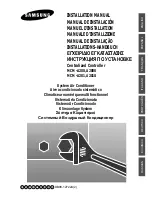
En-9
3. 6. 1. Pipe connection
■
Flaring
Use special pipe cutter and
fl
are tool designed for R410A or R32 pipework.
(1) Cut the connection pipe to the necessary length with a pipe cutter.
(2) Hold the pipe downward so that cuttings will not enter the pipe and remove any burrs.
(3) Insert
the
fl
are nut (always use the
fl
are nut attached to the indoor unit(s) and outdoor
unit or branch box respectively) onto the pipe and perform the
fl
are processing with a
fl
are tool. Use the special R410A or R32
fl
are tool, or the conventional
fl
are tool. Leak-
age of refrigerant may result if other
fl
are nuts are used.
(4) Protect the pipes by pinching them or with tape to prevent dust, dirt, or water from
entering the pipes.
Check if [L] is
fl
ared uniformly
and is not cracked or scratched.
Pipe
Die
B
A
L
Pipe outside
diameter
[mm (in.)]
Dimension A [mm]
Dimension B
-
0
0.4
[mm]
Flare tool for R32,
clutch type
6.35 (1/4)
0 to 0.5
9.1
9.52 (3/8)
13.2
12.70 (1/2)
16.6
15.88 (5/8)
19.7
19.05 (3/4)
24.0
When using conventional
fl
are tools to
fl
are R32 pipes, the dimension A should be
approximately 0.5 mm more than indicated in the table (for
fl
aring with R32
fl
are tools) to
achieve the speci
fi
ed
fl
aring. Use a thickness gauge to measure the dimension A.
Width across
fl
ats
Pipe outside
diameter [mm (in.)]
Width across
fl
ats
of Flare nut [mm]
6.35 (1/4)
17
9.52 (3/8)
22
12.70 (1/2)
26
15.88 (5/8)
29
19.05 (3/4)
36
NOTE
: The
fl
are nut speci
fi
cation is compliant with ISO14903.
■
Bending pipes
• If pipes are shaped by hand, be careful not to collapse them.
• Do not bend the pipes in an angle more than 90°.
• When pipes are repeatedly bend or stretched, the material will harden, making it dif
fi
cult
to bend or stretch them any more.
• Do not bend or stretch the pipes more than 3 times.
CAUTION
• To prevent breaking of the pipe, avoid sharp bends. Bend the pipe with a radius of
curvature of 150 mm or over.
• If the pipe is bent repeatedly at the same place, it will break.
■
Flare connection
CAUTION
• Be sure to apply the pipe against the port on the indoor unit correctly. If the centering
is improper, the
fl
are nut cannot be tightened smoothly. If the
fl
are nut is forced to
turn, the threads will be damaged.
• Do not remove the
fl
are nut from the indoor unit pipe until immediately before
connecting the connection pipe.
• Do not use mineral oil on
fl
ared part. Prevent mineral oil from getting into the system
as this would reduce the lifetime of the units.
(1) Detach the caps and plugs from the pipes.
(2) Centering the pipe against port on the indoor unit, turn the
fl
are nut with your hand.
(3) When the
fl
are nut is tightened properly by your hand, hold the body side coupling with
a separate spanner, then tighten with a torque wrench. (See the table below for the
fl
are nut tightening torques.)
CAUTION
• Hold the torque wrench at its grip, keeping it in the right angle with the pipe, in order
to tighten the
fl
are nut correctly.
• Tighten the
fl
are nuts with a torque wrench using the speci
fi
ed tightening method.
Otherwise, the
fl
are nuts could break after a prolonged period, causing refrigerant to
leak and generate a hazardous gas if the refrigerant comes into contact with a
fl
ame.
Connection pipe
Tighten with 2 wrenches.
Holding Wrench
Flare nut
Torque wrench
Indoor unit pipe
(Body side)
Flare nut [mm (in.)]
Tightening torque [N·m (kgf·cm)]
6.35 (1/4) dia.
16 to 18 (160 to 180)
9.52 (3/8) dia.
32 to 42 (320 to 420)
12.70 (1/2) dia.
49 to 61 (490 to 610)
15.88 (5/8) dia.
63 to 75 (630 to 750)
19.05 (3/4) dia.
90 to 110 (900 to 1,100)
3. 7. Fresh air intake
■
Processing before use
(1) When taking in fresh air, cut out the slit of the cabinet on the left side of the outer case
with nippers.
Slit
Cabinet (iron plate)
CAUTION
• When removing the cabinet (iron plate), be careful not to damage the indoor unit
internal parts and surrounding area (outer case).
• When processing the cabinet (iron plate), be careful not to injure yourself with burrs,
etc.
• When using the Fresh air intake, set the Room temperature sensor switching (Aux.)
to “Wired Remote Controller” (01), or to use the Remote sensor.
(2) Install the round
fl
ange to the fresh air intake.
Round
fl
ange (Locally purchased)
(3) Connect the duct to the round
fl
ange.
(4) Seal with a band and vinyl tape, etc. so that air does not leak from the connection.
Duct
9381386215-01_IM.indb 9
9381386215-01_IM.indb 9
12/5/2018 2:57:36 PM
12/5/2018 2:57:36 PM


































